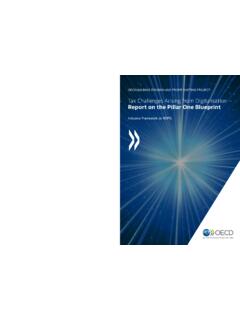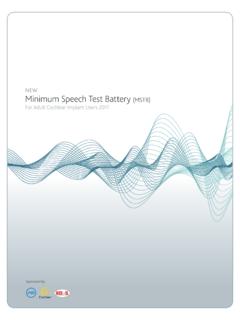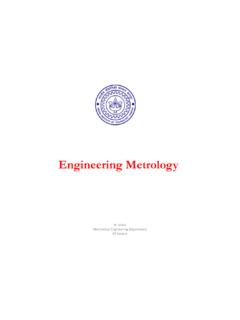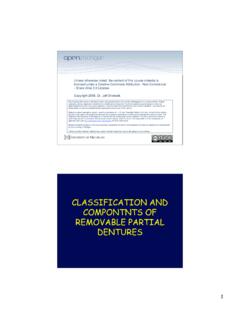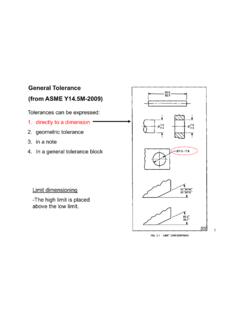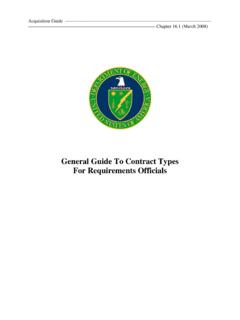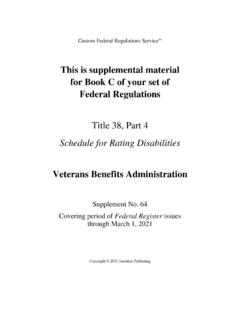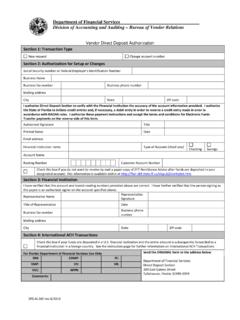Transcription of American Academy of Audiology Hearing Screening …
1 American Academy of Audiology Childhood Hearing Screening Guidelines September 2011 The charge of the Subcommittee on Childhood Hearing Screening was to develop evidence based recommendations for Screening Hearing of children age 6 months through high school. Committee members and contributors Chair: Karen L. Anderson, PhD, Karen L. Anderson Audiology Consulting, Minneapolis, MN Members: Candi Bown; Nebo School District, Springville UT; Melissa R. Cohen, AuD., Cobb County Public Schools, Atlanta GA; Susan Dilmuth Miller, AuD., East Stroudsburg University, East Stroudsburg, PA; Donna Fisher Smiley, PhD, Arkansas Children s Hospital, Little Rock, AR; Debra Gwinner, AuD. Cherry Creek Schools, Greenwood Village, CO; Barbara Lambright, AuD, Cherry Creek Schools, Greenwood Village, CO; Barb Norris, , Consultant; Erin Plyler, AuD., University of Tennessee Health Science Center, Knoxville, TN; Aparna Rao, PhD, University of Minnesota, Minneapolis, MN; Jane Seaton, MS.
2 , Seaton Consultants, Athens, GA; Victoria Walkup Pierce, AuD, Orange County Public Schools, Orlando, FL; Contributors: Kathryn Bright, PhD., University of Northern Colorado, Greeley, CO; John Eichwald, MS; CDC/EHDI, Atlanta, GA; Jay Hall III, PhD, University of Florida, Gainesville FL; Wendy D. Hanks, , Gallaudet University, Washington DC; Brad Ingrao, AuD., Sound Advice Hearing Solutions; Pat Mauceri, AuD., Northeastern University in Boston, MA Kimberly Miller, AuD., Thompson R2 J School District, Loveland, CO; Gail Tanner, , Illinois Department of Public Health; EXECUTIVE SUMMARY The American Academy of Audiology endorses detection of Hearing loss in early childhood and school aged populations using evidence based Hearing Screening methods. Hearing loss is the most common developmental disorder identifiable at birth and its prevalence increases throughout school age due to the additions of late onset, late identified and acquired Hearing loss.
3 Under identification and lack of appropriate management of Hearing loss in children has broad economic effects as well as a potential impact on individual child educational, cognitive and social development. The goal of early detection of new Hearing loss is to maximize perception of speech and the resulting attainment of linguistic based skills. Identification of new or emerging Hearing loss in one or both ears followed by appropriate referral for diagnosis and treatment are first steps to minimizing these effects. Informing educational staff, monitoring chronic or fluctuating Hearing loss, and providing education toward the prevention of Hearing loss are important steps that are needed to follow mass Screening if the impact of Hearing loss is to be minimized. 1 Summary of Hearing Screening Recommendations* * Refer to the full Guidelines document for more detail on these recommendations.
4 Note that the following guidelines are considered to be the minimum standard for educational settings. Programs are encouraged to follow a more intensive rescreening and referral protocol where staffing patterns permit. Pure tone Screening 1. Perform biological check on pure tone Screening equipment prior to daily Screening . 2. Screen populations age 3 (chronologically and developmentally) and older using pure tone Screening . 3. Perform a pure tone sweep at 1000, 2000, and 4000 Hz at 20 dB HL. 4. Present a tone more than once but no more than 4 times if a child fails to respond. 5. Only screen in an acoustically appropriate Screening environment. 6. Lack of response at any frequency in either ear constitutes a failure. 7. Rescreen immediately. 8. Use tympanometry in conjunction with pure tone Screening in young child populations ( , preschool, kindergarten, grade 1).
5 9. Screen for high frequency Hearing loss where efforts to provide education on Hearing loss prevention exist. 10. minimum grades to be screened: preschool, kindergarten, and grades 1, 3, 5 and either 7 or 9. Tympanometry Screening 1. Calibrate tympanometry equipment daily. 2. Tympanometry should be used as a second stage Screening method following failure of pure tone or otoacoustic emissions Screening . 3. Use defined tympanometry Screening and referral criteria: a 250 daPa tympanometric width is the recommended criterion. If it is not possible to use tympanometric width then mmhos static compliance can be used as the criterion. A final choice for failure criterion is negative pressure of > 200 daPa to 400 daPa however it is not appropriate for this criterion to stand alone to elicit a referral. 4. Young child populations should be targeted for tympanometry Screening .
6 5. Use results of pure tone or OAE and tympanometry rescreening to inform next steps. Rescreening 1. Rescreen with tympanometry after a defined period: after failing the immediate pure tone rescreening and in 8 10 weeks for children failing pure tone or OAE Screening and tympanometry. 2. Do not wait to perform a second stage Screening on children who fail pure tone Screening only. 2 OAE 1. Use only for preschool and school age children for whom pure tone Screening is not developmentally appropriate (ability levels < 3 years). 2. Calibrate OAE equipment daily. 3. Maintain primary DPOAE levels at 65/55 dB SPL. 4. Select DPOAE or TEOAE cut off values carefully. 5. Default settings may no t be appropriate. 6. Screening programs using OAE technology must involve an experienced audiologist. 7. Children failing OAE should be screened with tympanometry.
7 Acoustic reflex testing, reflectometry and Hearing Screening using speech materials are not recommended. 3 TABLE OF CONTENTS I. INTRODUCTION a. Background and philosophy b. Prevalence of childhood Hearing loss c. Economic impact of Hearing loss d. Educational impact of Hearing loss i. Definition of normal Hearing ii. Minimal sensorineural Hearing loss iii. Unilateral Hearing loss iv. High frequency Hearing loss v. Hearing loss due to otitis media with effusion e. Population of children to be screened i. Early childhood ii. Preschool iii. School aged iv. Targeted grade levels II. METHODOLOGY a. Evidenced based review b. Sensitivity and Specificity c. British National Institute for Health Research d. Test Procedure and Protocol review i. Pure tone Screening 1. Intensity 2. Frequency 3. Number of presentations 4. Screening environment ii.
8 Immittance 1. Tympanometry a. Middle ear pressure b. Tympanometric width c. Static admittance (compliance) 2. Acoustic reflex and reflectometry iii. Screening with speech stimuli materials iv. Otoacoustic emissions 1. Measurement parameters 2. Screening considerations: environment and time 3. Transient evoked OAEs 4. Distortion product OAEs 5. Research summary 6. OAE limitations 7. OAE Future needs v. Rescreening III. DISCUSSION/RESULTS/RECOMMENDATIONS a. Protocol recommendations i. Pure tone Screening ii. Immittance 1. Tympanometry 2. Acoustic reflex and reflectometry 4 iii. Screening with Speech Stimuli Materials iv. Otoacoustic Emissions v. Rescreening b. Referral and follow up c. Program management i. Personnel and staff training ii. Scheduling iii. Equipment selection 1. Pure tone Screening equipment 2. Immittance Screening equipment 3.
9 Otoacoustic emissions Screening equipment iv. Equipment maintenance v. Infection control vi. Accountability vii. Evaluation IV. CONCLUSION/SUMMARY V. REFERENCES VI. APPENDICES 5 American Academy of Audiology Childhood Hearing Screening Guidelines INTRODUCTION Background and Philosophy Hearing loss is the most prevalent developmental abnormality present at birth (White, 1997). Identification of Hearing loss by 6 months of age in combination with quality early intervention services is associated with language development at or near the typical rate of development (Yoshinaga Itano, 1995; Yoshinaga Itano, 1998; Yoshinaga Itano, et al. 2000; Yoshinaga Itano, et al. 2004). Age appropriate language development and literacy outcomes require early and ongoing attention to skill development, and for the effects of Hearing loss on skill development and socialization to be prevented, it first is necessary for childhood Hearing loss to be identified.
10 This document provides a review of the current state of the art in pediatric Hearing Screening and recommends evidenced based protocols for the identification of Hearing loss in the preschool and school aged population. Need for Hearing Screening guidelines The presumption that Hearing loss can be reliably identified based on a child s behavior in everyday situations has been shown to be faulty by several studies documenting outcomes from the use of parent questionnaires (Olusanya, 2001; Gomes and Lichtig 2005; Lo et al. 2006). The Joint Committee on Infant Hearing (2007) identified ten risk factors for delayed onset or progressive Hearing loss in children. Evidence suggests that for 9 year olds with educationally significant Hearing loss, up to 50% will have passed newborn Hearing Screening (Fortnum et al. 2001). Finally, it is estimated that 9 10 per 1000 children will have identifiable permanent Hearing loss in one or both ears by school age (Sharagorodsky, Curhan, Curhan and Eavey, 2010; White, 2010).










